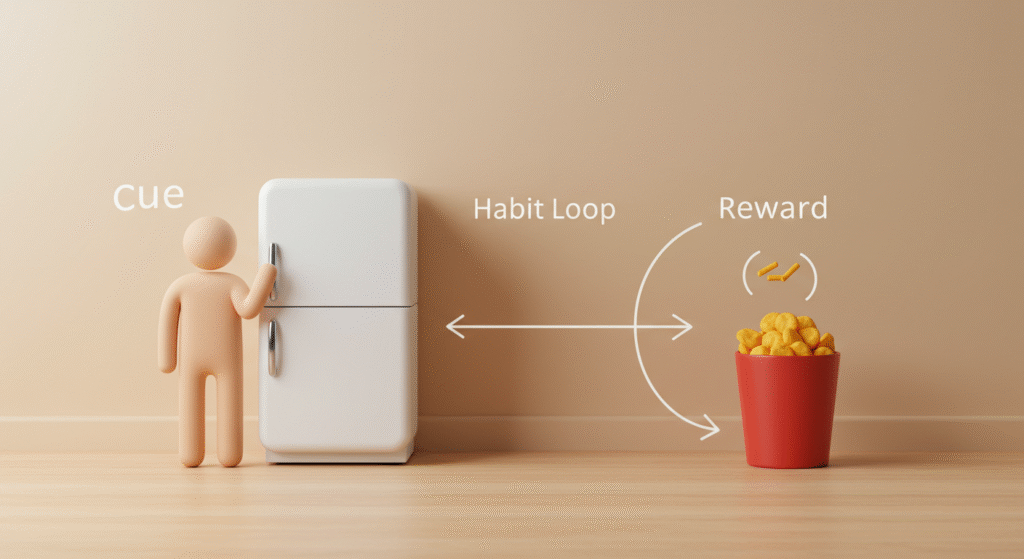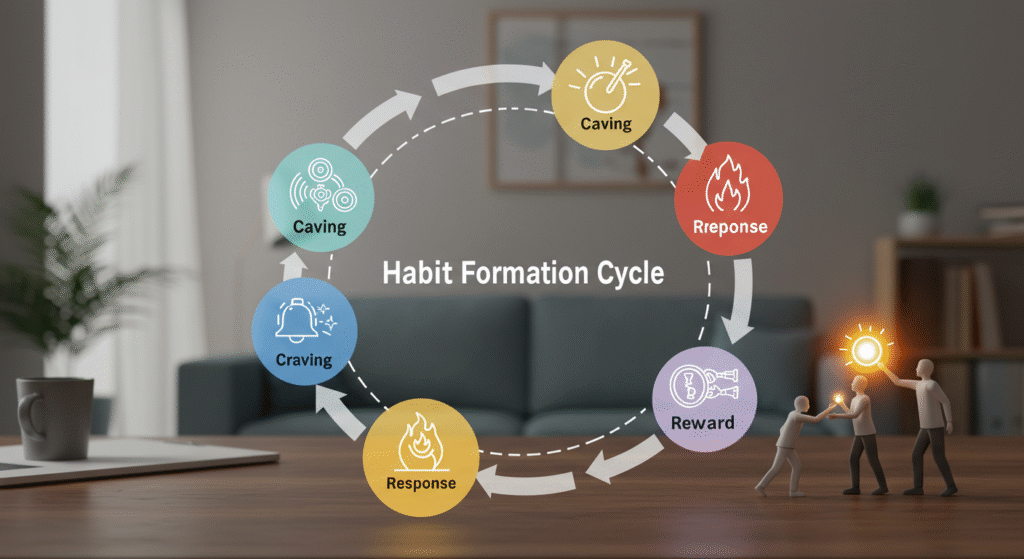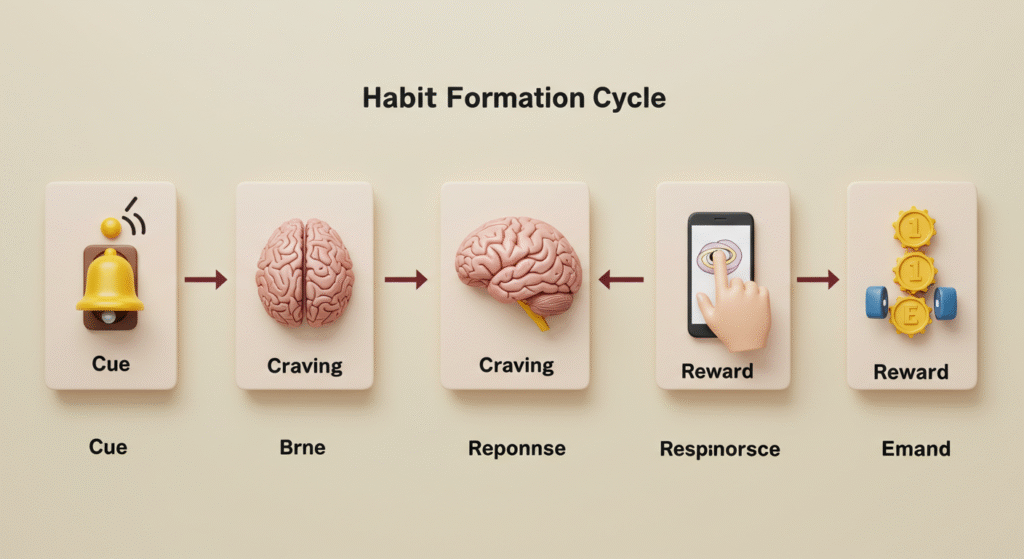Habit formation can be the difference between aspiration and achievement. Whether it’s exercising, eating healthier, or being more productive, habits are the foundation of meaningful change.
But why do some routines stick while others slip away like water through your fingers? The answer lies in understanding habit formation psychology and the principles of behavioral science.
This blog will unpack the science behind habits and offer actionable strategies to help you build routines that last.
From overcoming challenges to real-world success stories, we’ll cover it all. Use it as your go-to guide and start designing the life you want today.
Table of Contents
- The Psychology of Habit Formation
- The Role of Behavioral Science in Habit Formation
- Steps to Build Routines That Stick
- Common Challenges in Habit Formation and How to Overcome Them
- Real-Life Examples of Successful Habit Formation
- FAQs About Habit Formation and Behavioral Science
The Psychology of Habit Formation
Why are some actions automatic while others require willpower? It all comes down to the psychological mechanics of habit formation. A habit is a behavior triggered by a cue, performed routinely, and followed by a reward. This sequence is called the habit loop and consists of three parts:
- Cue – A trigger that initiates the behavior. This could be internal (stress) or external (an alarm).
- Routine – The actual behavior performed, such as brushing your teeth or checking your phone.
- Reward – The benefit or pleasure you gain, reinforcing the loop.
Research in habit formation psychology shows that habits are stored in a part of the brain called the basal ganglia.
When behaviors become habitual, they require less mental effort, freeing up cognitive resources for other tasks.
But why do bad habits form so easily? It’s because the brain favors immediate rewards over long-term benefits.
For instance, the dopamine spike from eating junk food is instant, while the reward of eating salad—better health—is delayed.
Behavioral science teaches us that pairing immediate gratification with your desired habit can help it take root.
Key Insight: Habits are forged through repetition, reward, and psychological reinforcement. The more intentional you are about these steps, the stronger the habit becomes.
The Role of Behavioral Science in Habit Formation
Behavioral science studies why humans act the way they do. When applied to habit formation, it reveals how to create environments conducive to positive behaviors and eliminate barriers to success. Here’s how behavioral science principles enhance habit formation:
1. Behavioral Triggers or Cues
Cues play a critical role in habit formation. Behavioral scientists suggest making your cues obvious and appealing. For example, placing workout clothes beside your bed acts as a visual reminder to exercise.
2. Reinforcement Theory
This principle states that behaviors are more likely to occur when rewarded. Even subtle rewards like a mental pat on the back can reinforce habits.
3. Motivation and Opportunity
According to the Fogg Behavior Model, successful habits require motivation, ability, and a prompt. When motivation dips, simplifying habits—like swapping a 30-minute run for a 10-minute walk—can improve long-term consistency.
4. Removing Friction
Small obstacles can derail a habit. Behavioral science suggests reducing friction. For instance, pre-chopping vegetables makes eating healthy easier.
Behavioral scientists also highlight the significance of the environment in promoting habits. People surrounded by cues encouraging positive behaviors are more likely to succeed.
Pro Tip: Manipulate your surroundings to support your habits. Want to quit smoking? Replace the sight of cigarettes with fresh fruits or gum.
Steps to Build Routines That Stick
Building a habit doesn’t happen overnight. It’s a process rooted in intention, repetition, and adjustment. Follow these steps to create routines that last:
1. Start Small
Focus on micro-habits. For example, instead of aiming to meditate for 30 minutes, start with 2 minutes daily. Once established, scale up.
2. Attach New Habits to Existing Routines
This technique, called “habit stacking,” leverages existing behaviors to anchor your new routine. Example: “After brushing my teeth, I’ll floss one tooth.”
3. Set Clear Intentions
Vague goals lead to vague results. Replace “I’ll exercise more” with “I’ll run for 20 minutes at 7 a.m. on Monday, Wednesday, and Friday.”
4. Track Your Progress
Keep yourself accountable by journaling or using apps to track habits. Reflecting on progress reinforces commitment.
5. Design Rewards
Pair actions with a treat. For instance, after completing a workout, enjoy your favorite smoothie.
6. Focus on Consistency, Not Perfection
Missing a day isn’t failure; use it to recalibrate. What’s critical is sticking with the habit over the long run.
| Step Number | Habit-Building Strategy | Description | Example |
|---|---|---|---|
| 1 | Start Small | Begin with manageable steps instead of overwhelming yourself. | Start with a 5-minute daily workout. |
| 2 | Identify Triggers | Link the new habit to an existing routine or schedule. | Meditate right after brushing teeth. |
| 3 | Set Specific Goals | Clearly define what you want to achieve and when. | “Exercise for 30 minutes at 7 a.m. on Monday, Wednesday, and Friday.” |
| 4 | Track Your Progress | Use tools like journals or apps to monitor your habits and improvements. | Track workout days using a fitness app. |
| 5 | Design Rewards | Motivate yourself by pairing the habit with a reward upon completion. | Enjoy a smoothie after workouts. |
| 6 | Focus on Consistency, Not Perfection | Accept occasional setbacks and prioritize building long-term commitment. | Return to the habit after missing a day. |
Types of Habits in Psychology
- Keystone Habits
These are habits that trigger a chain reaction and influence other behaviors. For example, regular exercise can lead to better eating habits, improved sleep, and increased productivity.
- Cognitive Habits
Cognitive habits include patterns of thinking and decision-making. Examples are positive self-talk, problem-solving approaches, or habitual ways of interpreting situations.
- Health Habits
These are behaviors related to maintaining physical well-being, such as eating nutritious meals, exercising regularly, and adhering to a proper sleep schedule.
- Social Habits
Social habits pertain to the way individuals interact with others. Examples include maintaining eye contact, active listening, and regular communication with loved ones.
- Productivity Habits
Productivity habits involve routines that help manage tasks and time effectively, such as planning daily goals, prioritizing work, and minimizing distractions.
- Destructive Habits
These are habits that negatively impact one’s life, such as procrastination, overeating, or excessive screen time. Recognizing and addressing destructive habits is essential for personal growth.
Common Challenges in Habit Formation and How to Overcome Them
Forming habits isn’t a smooth ride. Obstacles like lack of time, low motivation, or unexpected disruptions can derail your progress. Here’s how to tackle these challenges:
- Problem: “I don’t see results quickly enough.”
Solution: Focus on consistency over immediate payoff. Even small actions compound over time.
- Problem: “I lose motivation.”
Solution: Revisit your “why.” Align habits with meaningful goals to rekindle enthusiasm.
- Problem: “I’m too busy.”
Solution: Bundle habits with existing tasks. For example, listen to audiobooks during commutes.
- Problem: “I keep forgetting.”
Solution: Set reliable cues like alarms, sticky notes, or mobile reminders.
- Problem: “I slip after achieving success.”
Solution: Don’t treat milestones as the finish line. Treat habits as part of your identity.
Tip: Be kind to yourself when you stumble. Habit formation is a marathon, not a sprint.
Real-Life Examples of Successful Habit Formation
1. James Clear’s “1% Better” Philosophy
James Clear, author of Atomic Habits, advocates for making small, 1% improvements daily. This approach helped one of his followers lose 100 pounds by focusing on small dietary changes and daily exercise.
2. Jerry Seinfeld’s Productivity Hack
Comedian Jerry Seinfeld used the “Don’t Break the Chain” method to stay consistent with writing jokes. Each day he wrote, he marked an ‘X’ on the calendar, creating an unbroken chain of success.
3. Tech Giants Using Behavioral Triggers
Companies like Duolingo use streaks to encourage users to learn languages daily. The gamified rewards keep users motivated and engaged.
These cases demonstrate that leveraging the psychology of habits can drive everything from personal health goals to corporate success.
Habit Formation Cycle
The habit formation cycle consists of three key stages: cue, routine, and reward.
The cue is the trigger that signals the brain to initiate a particular behavior.
It could be a specific time, place, emotion, or event that prompts the action.
The routine represents the behavior itself, which can be as simple as brushing your teeth or as complex as a workout routine.
Finally, the reward is the outcome that reinforces the behavior, providing a sense of satisfaction or accomplishment.
Over time, this cycle becomes ingrained, turning the action into an automatic habit.
By understanding and leveraging this cycle, individuals and organizations can build and strengthen habits that support their goals.
FAQs About Habit Formation and Behavioral Science
1. How long does it take to form a habit?
Studies suggest forming a habit takes 21-66 days, depending on complexity and consistency.
2. Can bad habits be unlearned?
Yes! Replace bad habits by identifying cues and substituting them with healthier alternatives.
3. What role does willpower play in habit formation?
Willpower helps in the early stages, but habits rely more on automation than discipline.
4. How can I use behavioral science for long-term behavior change?
Focus on motivation, reducing friction, and reinforcing behavior with rewards.
5. Are there tools to help track habits?
Yes. Apps like Habitica and Streaks can aid in monitoring and motivating habit formation.
6. What is habit formation in behaviorism?
Habit formation in behaviorism refers to the process of developing automatic behaviors through repetition and reinforcement, where certain stimuli consistently trigger specific responses over time.
7. What are the 4 stages of habit formation?
The 4 stages of habit formation are cue, craving, response, and reward. The cue triggers the habit, the craving provides the motivation, the response is the action taken, and the reward reinforces the behavior.
8. What is the difference between a behavior and a habit?
A behavior is any action performed by an individual, often consciously and deliberately, while a habit is a repeated behavior that has become automatic and requires little to no conscious thought.
9. What is the golden rule of habits?
The golden rule of habits is to keep the cue and reward the same while altering the routine to change a habit successfully.
10. What is the science behind habit formation?
Habit formation is rooted in the brain’s reward system, particularly the basal ganglia, which helps automate repeated actions. Through consistent practice, behaviors transition from conscious efforts to automatic routines, reinforced by cues and rewards.
By marrying behavioral science with actionable steps, you can master the art of building habits that stick. Remember, successful habit formation starts small but builds big.







